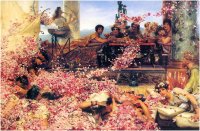Truth or (ancient) fiction?
 I recently went with my family to visit the fabulous Alma-Tadema exhibition in Rome at the Chiostro del Bramante.
I recently went with my family to visit the fabulous Alma-Tadema exhibition in Rome at the Chiostro del Bramante.
Sir Lawrence Alma-Tadema was a Dutch artist who moved to England and became part of the late nineteenth century Pre-Raphaelite movement.
Although not as well known as Dante Gabriel Rossetti or Edward Burnes-Jones, Alma-Tadema’s artwork was much prized at the height of the Pre-Raphaelite movement, and then, along with the other Pre-Raphaelite artistists, fell into disfavor/out of fashion following the First World War.
The Rome exhibition of Alma-Tadema and the English 19th century artists boasted many works from the private Perez-Simon collection, in Mexico.
Alma-Tadema, like many of his contemporaries, enjoyed painting subjects from Ancient Greece and Rome. One of his masterpieces was on display at this exhibition.
The roses of Heliogabalus (1888) may or may not depict a real-life event during the reign of Heliogabulus, who took on the name of Emperor Marcus Aurelius Antonius during his reign over Rome (219-222 A.D.)
 Known for his depraved parties and sexual excesses, Emperor Heliogabulus observes the scene depicted in Alma-Tadema’s painting.
Known for his depraved parties and sexual excesses, Emperor Heliogabulus observes the scene depicted in Alma-Tadema’s painting.
This painting illustrates a story about how Emperor Heliogabulus, at one of his lavish banquets, arranged for a false ceiling to release masses of perfumed roses and violets onto the guests and the Emperor’s own concubines, burying them under the weight of the petals, and suffocating them.
Truth or Ancient Metropolitan legend? It’s hard to know for certain. When Emperors died, their successors often spearheaded ancient smear campaigns against their predecessors. Heliogabulus was already known for his excesses, so the stories may have been fabricated. This story is recounted in the 4th century Historia Augusta, but most scholars believe it’s an exaggeration.
Nevertheless, most authors will be impressed by this story that enjoys nearly two millenia of staying power. And Alma-Tadema’s depiction of this grim yet fragrant end to the lives of Ancient Roman banquet invitees is spectacular. My kids were amazed by the painting and the cruel event it depicts.
So – fact or (ancient) fiction? It hardly matters. A story this good is pretty hard to forget.
What a cruel way to kill! You’re right, true of false, stories like this one feed our imaginations.
Thanks, Evelyne. True – I really love myths and legends for this reason. Although, living in Rome I get to witness all the sites where Roman Emperors really were so cruel, so not hard to see why a story like this might be believed.